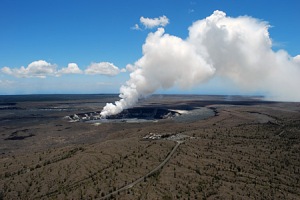Reprinted from here.
A plume of volcanic gas and ash rises from a vent on the east side of Halema`uma`u Crater, at the summit of Kīlauea caldera. The Hawaiian Volcano Observatory and Jaggar Museum of Volcanology are in the foreground.
After one year, Kīlauea's summit eruption is still going strong
(To see a recent video of Halema'uma'u eruption, go here)
It seems like only yesterday when the Hawaiian Volcano Observatory (HVO) monitored a several-week build-up in seismic tremor levels and sulfur dioxide emissions in early 2008. While some staff members speculated that a small summit eruption might be on the way, others were convinced, from the lack of earthquake activity and deformation, that Pele was just restless, and that a summit eruption was unlikely.
Then, on March 12, 2008, an area of gas emission formed on the east wall of Halema`uma`u Crater, within Kīlauea's caldera. The extreme temperature of the gases caused the vent to glow at night, attracting tourists and locals alike to the viewpoint at the Jaggar Museum of Volcanology. Hawai`i Volcanoes National Park closed the south part of the caldera to visitors in response to the increased concentrations of hazardous gases—a closure which remains in effect today.
The real surprise occurred at 2:58 a.m. on March 19, 2008, when a small explosion occurred from the site of the gas emission. The explosion—the first at Kīlauea's summit since 1924-threw rocks and boulders over about 40 hectares (100 acres), destroying the Halema`uma`u tourist overlook, blanketing the Halema`uma`u parking lot with rocks and ash, and marking the start of the summit eruption that continues to this day.
Since that event almost one year ago, thousands of tonnes of sulfur dioxide and other volcanic gases have issued from the March 19 explosion crater. The gas has had a tremendous impact on the residents of Hawai`i Island, damaging crops on the south part of the island and worsening existing health problems for people from Hilo to Kona.
Despite the widespread effects of the gas emissions, very little lava has erupted from the vent. A small amount of ash is produced every day, but the bulk of the lava that erupted has been the result of occasional explosions that occurred throughout 2008 (none have occurred in 2009-yet). Near-daily ash collection and mapping of explosive deposits reveal that the total amount of lava and ash erupted is too small to even fill your local supermarket! In fact, the amount of lava and ash produced by the summit eruption is equivalent to what is erupted from Kīlauea's east rift zone in just five hours.
Even though only a small amount has actually erupted, lava has been seen within the vent. Visual observations identified a lava lake about 300 feet below the vent rim in September and October 2008. In February 2009, images from an infrared camera, which is able to see through much of the gas plume, saw a lava lake at a greater depth, about 450 feet below the rim. This lake has recently been replaced by a series of small, spattering vents, still well below the floor of Halema`uma`u Crater.
The current summit eruption has already surpassed the length of all previous summit eruptions at Kīlauea since 1924. In December 2008, HVO scientists thought that the eruption actually might be coming to a close, since activity diminished markedly. Instead of dense, white, roiling, emissions, the plume was wispy, thin, and lazy. Glow disappeared from the vent, and seismic tremor levels dropped considerably.
Of course, Pele was just being her usual, devious self. In January, the return of weak glow and a strong, white plume signaled the renewal of the summit eruption. One year in, there are no signs that the eruption will be ending anytime soon.
The past year has been one of surprises, to say the least. The type of activity currently on display at Kīlauea's summit is unprecedented in the nearly 200 years of recorded eruptions. HVO will continue to closely monitor the eruption to improve our knowledge of how Kīlauea works and to watch for signs of clearing air that might signify the end of this chapter of Kīlauea's history.
Activity update
The Waikupanaha ocean entry remains active, and a small collapse early Wednesday morning (3/11) removed part of the delta there. West of the ocean entry, lava flows were active on the coastal plain and had reached to within 180 m (200 yds) of the ocean near Kupapa`u by mid-morning on Wednesday.
At Kīlauea's summit, the vent within Halema`uma`u Crater continues to emit elevated amounts of sulfur dioxide gas, resulting in high concentrations of sulfur dioxide downwind. Lava remains just out of sight more than 90 m (100 yds) below the vent rim.
Visit our Web site (http://hvo.wr.usgs.gov) for detailed Kīlauea and Mauna Loa activity updates, recent volcano photos, recent earthquakes, and more; call (808) 967-8862 for a Kīlauea summary; email questions to askHVO@usgs.gov. ![]()
For more information on traveling to Hawai in general and seeing the volcanoes of the Big Island in particular, please visit www.tourguidehawaii.com and www.lovingthebigisland.wordpress.com.


No comments:
Post a Comment